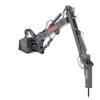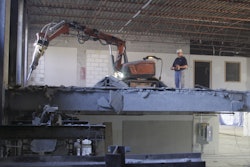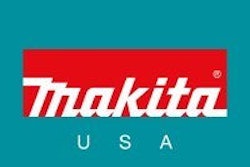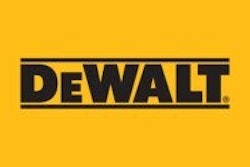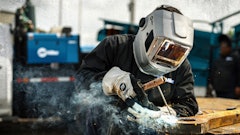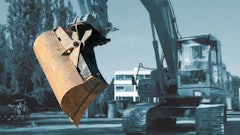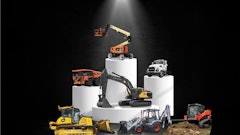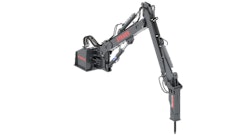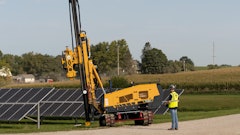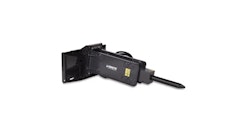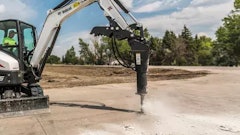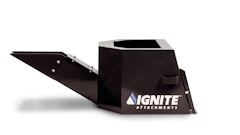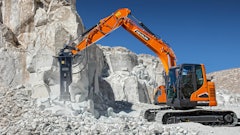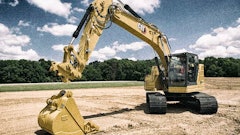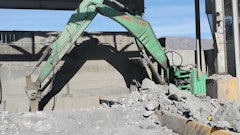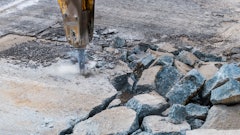
A rotary hammer is designed for frequent drilling in concrete. Leading applications include setting anchor bolts, rebar doweling and drilling through concrete. Larger rotary hammers can also be used for light to medium duty demolition work and cleanup after form building.
There are several factors to consider when choosing between a rotary hammer and its close cousin, the hammer drill. "These include size of hole, frequency of holes to be drilled, depth of hole and hardness of material," says Jeff Beck, product manager, DeWalt. "In general, as the size of hole and frequency increase, a rotary hammer should be the tool of choice."
In addition, the harder the material, the less effective a hammer drill will be. As such, a rotary hammer is better suited for applications involving commercial concrete, or especially precast concrete where psi ratings are higher than residential concrete mixes or masonry products.
A growing variety of features gives you a lot to contemplate when selecting a rotary hammer for your applications. The addition of various user benefits can result in improved worker productivity and tool efficiency.
Enhancing Ergonomics
In recent years, manufacturers of rotary hammers have introduced a host of innovations. Ergonomic features, in particular, have benefited both the worker and tool performance.
If you've worked with any sort of drilling tool, you know the twisting reaction it can produce when it gets hung up on something in the material. The larger and more powerful the tool, the more dangerous that twisting can be. Internal torque control mechanisms, found in all rotary hammers, help limit this reaction.
"A contractor needs to be able to use a rotary hammer in awkward drilling situations. He also needs to have more torque control over the tool in these situations because hitting rebar can cause the tool to bind up," explains Adam Livingston, product manager, Makita. "Our Auto Clutch System reduces gear damage by automatically disengaging the gears if the bit binds."
Vibration reduction is another hot issue in rotary hammers. According to Mitch Burdick, product manager for hammers at Bosch, vibration levels are highly regulated and enforced in Europe. While such is not the case in the U.S., less vibration can benefit end users by allowing them to work more comfortably and for longer periods.
Tool manufacturers have differing methods for achieving lower vibration. For example, DeWalt's SHOCKS Active Vibration Control is a free-floating handle in corded SDS and Spline/Max units that reduces vibration in all directions.
Makita's AVT (Anti-Vibration Technology) takes a different approach to a counterbalance system. "Makita AVT is an internal counterbalance system that reduces vibration and directs more hammering energy to the work surface," Livingston asserts.
Bosch's Vibration Control achieves less vibration without use of a counterbalance system. "Our engineers figured out a way to increase the air cushion between the hammer piston and the striker pin, and, similar to a longer spring, we were able to take out vibration and increase impact energy at the same time," Burdick says.
Dust Control
Reducing jobsite dust increases worker safety and keeps a jobsite clean, among other benefits. The ability to keep dust particles out of the air is especially important when working in sensitive areas, such as rehabs in occupied buildings, grocery stores, schools and around electronics.
Dust containment systems for rotary hammers typically come in two varieties: a port attachment that connects to the tool and then connects to a vacuum, or a dedicated vacuum attachment that fits right to the tool. While the former offers a large amount of debris storage, the latter gives you a portable dust collection option. These dedicated attachments also typically offer an internal motor and delayed shutoff of the vacuum to ensure the maximum amount of dust is collected after the tool stops working.
Cutting the Cord
It wasn't until the rise of lithium-ion battery technology about six years ago that cordless rotary hammers became a reality.
"One of the key benefits of lithium-ion is it allows you to put a lot of power in a compact size," says Nick Feld, product manager for cordless hammers at Bosch. "This introduced a new world of tools -- particularly rotary hammers -- where we could provide near-corded performance in a cordless tool."
Several manufacturers now offer cordless rotary hammers for users who need to "cut the cord," so to speak.
When considering a cordless rotary hammer purchase, Ethan Haughawout, Makita product manager - cordless products, says you must weigh the benefits and match the right tool to the application. An 18-volt lithium-ion rotary hammer offers an optimal power-to-weight ratio for a range of concrete drilling applications, including overhead work, while 36-volt rotary hammers deliver corded speed with the convenience of a cordless tool.
Feld elaborates, "Contractors who are using corded tools are performing applications that require them to drill holes all day long. On the cordless side, typically the reason for making a purchase is more for portability. They're not necessarily drilling holes all day, but working in an application where they need the convenience of a compact size and a lightweight tool, as well as good performance."
------------------
6 Simple Rotary Hammer Maintenance Tips
The concrete working environment is a tough one on any tool. Here are a few tips to help keep your rotary hammer working efficiently.
- Stop pressing so hard and let the tool do the work.
- et the material you're drilling and the size of hammer determine the type of bit you use.
- Wipe off any dirt and debris from the end of the bit that goes into the hammer to prevent tool holder failure and jamming.
- Grease the bit shank every time you change bits to prevent premature wear of the bit holder.
- Use manufacturer-recommended grease and follow weight and viscosity guidelines.
- Know what your tool's LED service lights mean and follow the recommended maintenance guidelines when they alert you.
Rebecca Wasieleski is editor of Construction Distribution, a publication for distributors of construction supplies, tools, fasteners and related products. For more information, visit www.ConstructionDistribution. com.




